2014 SUBARU TRIBECA airbag off
[x] Cancel search: airbag offPage 10 of 426
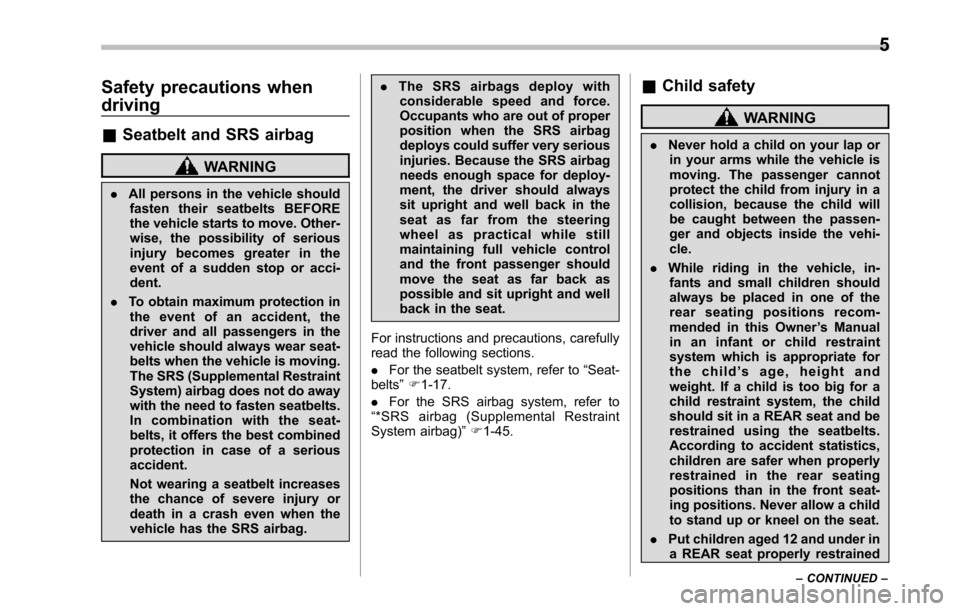
Safety precautions when
driving
&Seatbelt and SRS airbag
WARNING
.All persons in the vehicle shouldfasten their seatbelts BEFOREthe vehicle starts to move. Other-wise, the possibility of seriousinjury becomes greater in theevent of a sudden stop or acci-dent.
.To obtain maximum protection inthe event of an accident, thedriver and all passengers in thevehicle shouldalways wear seat-belts when the vehicle is moving.The SRS (Supplemental RestraintSystem) airbag does not do awaywith the need to fasten seatbelts.In combination with the seat-belts, it offers the best combinedprotection in case of a seriousaccident.
Not wearing a seatbelt increasesthe chance of severe injury ordeath in a crash even when thevehicle has the SRS airbag.
.The SRS airbags deploy withconsiderable speed and force.Occupants who are out of properposition when the SRS airbagdeploys could suffer very seriousinjuries. Because the SRS airbagneeds enough space for deploy-ment, the driver should alwayssit upright and well back in theseat as far from the steeringwheel as practical while stillmaintaining full vehicle controland the front passenger shouldmove the seat as far back aspossible and sit upright and wellback in the seat.
For instructions and precautions, carefullyread the following sections.
.For the seatbelt system, refer to“Seat-belts”F1-17.
.For the SRS airbag system, refer to“*SRS airbag (Supplemental RestraintSystem airbag)”F1-45.
&Child safety
WARNING
.Never hold a child on your lap orin your arms while the vehicle ismoving. The passenger cannotprotect the child from injury in acollision, because the child willbe caught between the passen-ger and objects inside the vehi-cle.
.While riding in the vehicle, in-fants and small children shouldalways be placed in one of therear seating positions recom-mended in this Owner’s Manualin an infant or child restraintsystem which is appropriate forthe child’sage,heightandweight. If a child is too big for achild restraint system, the childshould sit in a REAR seat and berestrained using the seatbelts.According to accident statistics,children are safer when properlyrestrained in the rear seatingpositions than in the front seat-ing positions. Never allow a childto stand up or kneel on the seat.
.Put childrenaged 12 and under ina REAR seat properly restrained
5
–CONTINUED–
Page 22 of 426
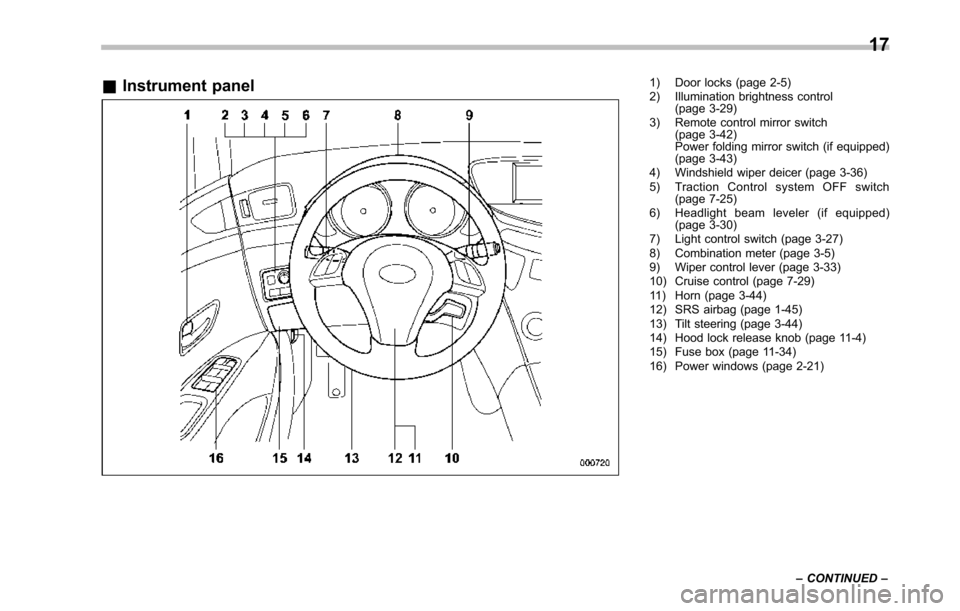
&Instrument panel1) Door locks (page 2-5)2) Illumination brightness control(page 3-29)3) Remote control mirror switch(page 3-42)Power folding mirror switch (if equipped)(page 3-43)4) Windshield wiper deicer (page 3-36)5) Traction Control system OFF switch(page 7-25)6) Headlight beam leveler (if equipped)(page 3-30)7) Light control switch (page 3-27)8) Combination meter (page 3-5)9) Wiper control lever (page 3-33)10) Cruise control (page 7-29)11) Horn (page 3-44)12) SRS airbag (page 1-45)13) Tilt steering (page 3-44)14) Hood lock release knob (page 11-4)15) Fusebox (page 11-34)16) Power windows (page 2-21)
17
–CONTINUED–
Page 27 of 426
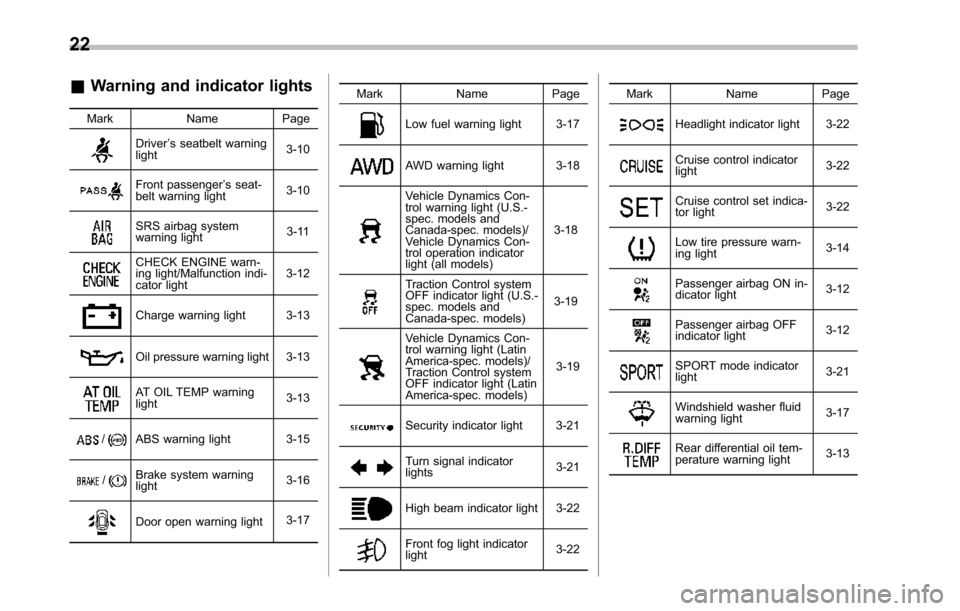
22
&Warning and indicator lights
Mark Name Page
Driver’s seatbelt warninglight3-10
Front passenger’s seat-belt warning light3-10
SRS airbag systemwarning light3-11
CHECK ENGINE warn-ing light/Malfunction indi-cator light3-12
Charge warning light 3-13
Oil pressure warning light3-13
AT OIL TEMP warninglight3-13
/ABS warning light 3-15
/Brake system warninglight3-16
Door open warning light3-17
Mark Name Page
Low fuel warning light 3-17
AWD warning light 3-18
Vehicle Dynamics Con-trol warning light (U.S.-spec. models andCanada-spec. models)/Vehicle Dynamics Con-trol operation indicatorlight (all models)
3-18
Traction Control systemOFF indicatorlight (U.S.-spec. models andCanada-spec. models)
3-19
Vehicle Dynamics Con-trol warning light (LatinAmerica-spec. models)/Traction Control systemOFF indicator light (LatinAmerica-spec. models)
3-19
Security indicator light 3-21
Turn signal indicatorlights3-21
High beam indicator light3-22
Front fog light indicatorlight3-22
Mark Name Page
Headlight indicator light 3-22
Cruise control indicatorlight3-22
Cruise control set indica-tor light3-22
Low tire pressure warn-ing light3-14
Passengerairbag ON in-dicator light3-12
Passenger airbag OFFindicator light3-12
SPORT mode indicatorlight3-21
Windshield washer fluidwarning light3-17
Rear differential oil tem-perature warning light3-13
Page 38 of 426
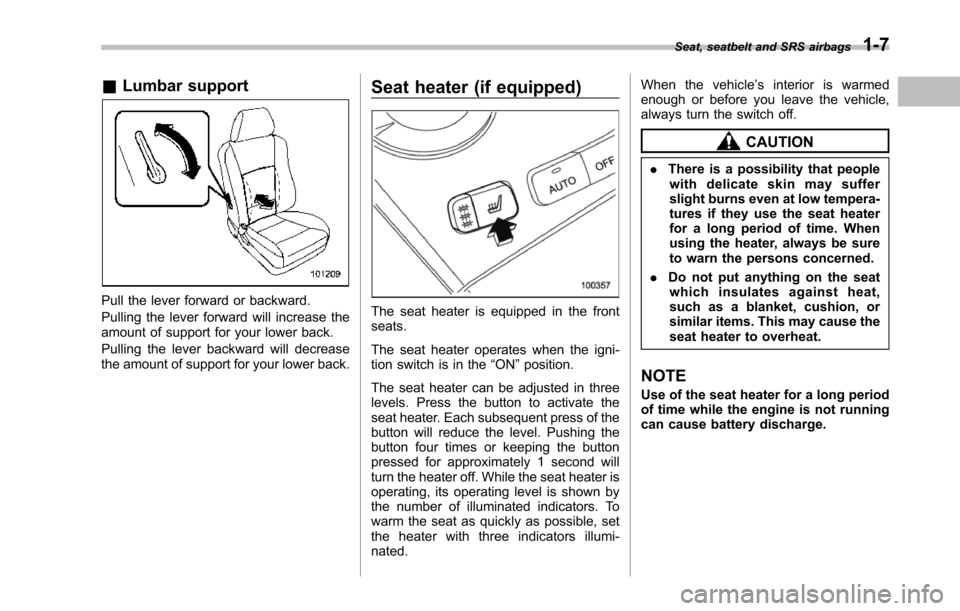
&Lumbar support
Pull the lever forward or backward.
Pulling the lever forward will increase theamountof support for your lower back.
Pulling the lever backward will decreasethe amount of support for your lower back.
Seat heater (if equipped)
Theseat heater is equipped in the frontseats.
Theseat heater operates when the igni-tion switch is in the“ON”position.
The seat heater can be adjusted in threelevels. Press the button to activate theseat heater. Each subsequent press of thebutton will reduce the level. Pushing thebutton four times or keeping the buttonpressed for approximately 1 second willturn the heater off. While the seat heater isoperating, its operating level is shown bythe number of illuminated indicators. Towarm the seat as quickly as possible, setthe heater with three indicators illumi-nated.
When the vehicle’s interior is warmedenough or before you leave the vehicle,always turn the switch off.
CAUTION
.There is a possibility that peoplewith delicate skin may sufferslightburns even at low tempera-tures if they use the seat heaterfor a long period of time. Whenusing the heater, always be sureto warn the persons concerned.
.Do not put anything on the seatwhich insulates against heat,such as a blanket, cushion, orsimilaritems. This may cause theseat heater to overheat.
NOTE
Use of the seat heater for a long periodof time while the engine is not runningcan cause battery discharge.
Seat, seatbelt and SRS airbags1-7
Page 71 of 426
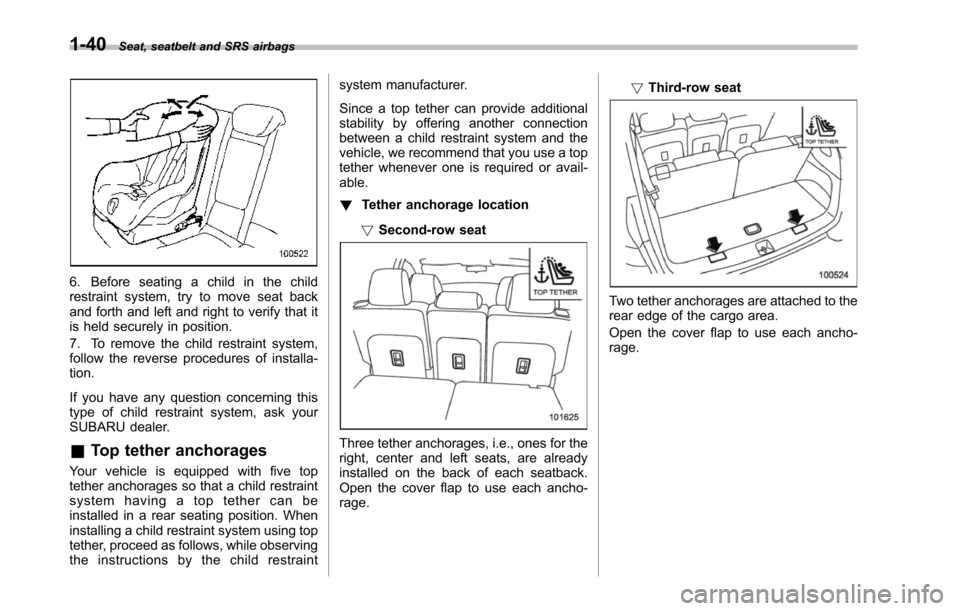
1-40Seat, seatbelt and SRS airbags
6. Before seating a child in the childrestraint system, try to move seat backand forth and left and right to verify that itis held securely in position.
7. To remove the child restraint system,follow the reverse procedures of installa-tion.
If you have any question concerning thistype of child restraint system, ask yourSUBARU dealer.
&Top tether anchorages
Your vehicle is equipped with five toptether anchorages so that a child restraintsystem having a top tether can beinstalled in a rear seating position. Wheninstalling a child restraint system using toptether, proceed as follows, while observingthe instructions by the child restraint
system manufacturer.
Since a top tether can provide additionalstability by offering another connectionbetween a child restraint system and thevehicle, we recommend that you use a toptether whenever one is required or avail-able.
!Tether anchorage location
!Second-row seat
Three tether anchorages, i.e., ones for theright, centerand left seats, are alreadyinstalled on the back of each seatback.Open the cover flap to use each ancho-rage.
!Third-row seat
Two tether anchorages are attached to therear edge of the cargo area.
Open the cover flap to use each ancho-rage.
Page 76 of 426
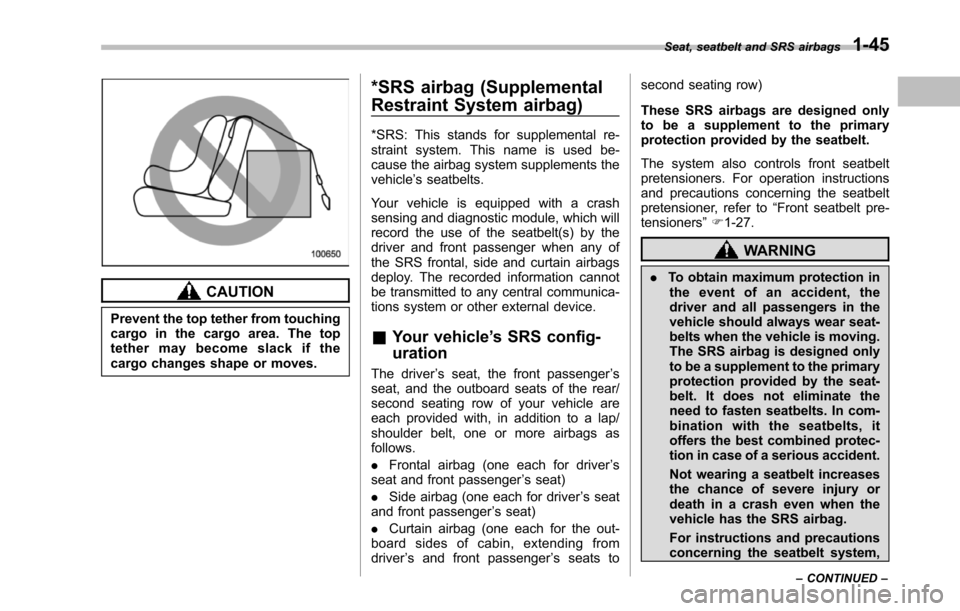
CAUTION
Prevent the top tether from touchingcargo in the cargo area. The toptether may become slack if thecargo changes shape or moves.
*SRS airbag (Supplemental
Restraint System airbag)
*SRS: This stands for supplemental re-straint system. This name is used be-cause the airbag system supplements thevehicle’s seatbelts.
Your vehicle is equipped with a crashsensing and diagnostic module, which willrecord the use of the seatbelt(s) by thedriver and front passenger when any oftheSRS frontal, side and curtain airbagsdeploy. The recorded information cannotbe transmitted to any central communica-tions system or other external device.
&Your vehicle’s SRS config-
uration
The driver’s seat, the front passenger’sseat, and the outboard seats of the rear/second seating row of your vehicle areeach provided with, in addition to a lap/shoulder belt, one or more airbags asfollows.
.Frontal airbag (one each for driver’sseat and front passenger’s seat)
.Side airbag (one each for driver’s seatand front passenger’s seat)
.Curtain airbag (one each for the out-board sides of cabin, extending fromdriver’s and front passenger’s seats to
second seating row)
These SRS airbags are designed onlyto be a supplement to the primaryprotection provided by the seatbelt.
The system also controls front seatbeltpretensioners. For operation instructionsand precautions concerning the seatbeltpretensioner, refer to“Frontseatbelt pre-tensioners”F1-27.
WARNING
.To obtain maximum protection inthe event of an accident, thedriverand all passengers in thevehicle should always wear seat-belts when the vehicle is moving.The SRS airbag is designed onlyto be a supplement to the primaryprotection provided by the seat-belt. It does not eliminate theneed to fasten seatbelts. In com-bination with the seatbelts, itoffers the best combined protec-tion in case of a serious accident.
Not wearing a seatbelt increasesthe chance of severe injury ordeath in a crash even when thevehicle has the SRS airbag.
For instructions and precautionsconcerning the seatbelt system,
Seat, seatbelt and SRS airbags1-45
–CONTINUED–
Page 79 of 426

1-48Seat, seatbelt and SRS airbags
!Components
1) Airbag control module (including impactand rollover sensors)2) Frontal airbag module (driver’s side)3) Frontal airbag module (front passenger’sside)4) Front sub sensor (left-hand side)
5) Front sub sensor (right-hand side)6) Side airbag module (driver’s side)7) Side airbag module (front passenger’sside)8) Side airbag sensor (center pillar left-handside)
9) Side airbag sensor (center pillar right-hand side)10) Airbag wiring11) Seatbelt pretensioner (driver’s side)12) Seatbelt pretensioner (front passenger’sside)13) Curtain airbag sensor (rear wheel houseright-hand side)14) Curtain airbag sensor (rear wheel houseleft-hand side)15) Curtain airbag module (right-hand side)16) Curtain airbag module (left-hand side)17) Seatbelt buckle switch (front passenger’sside)18) Front passenger’s seatbelt tension sen-sor19) Front passenger’s occupant detectionsystem weight sensor20) Front passenger’s occupant detectioncontrol module21) Front passenger’s frontal airbag ON andOFF indicator22) SRS airbag system warning light23) Satellite safing sensor (under the sec-ond-row center seat)
Page 83 of 426
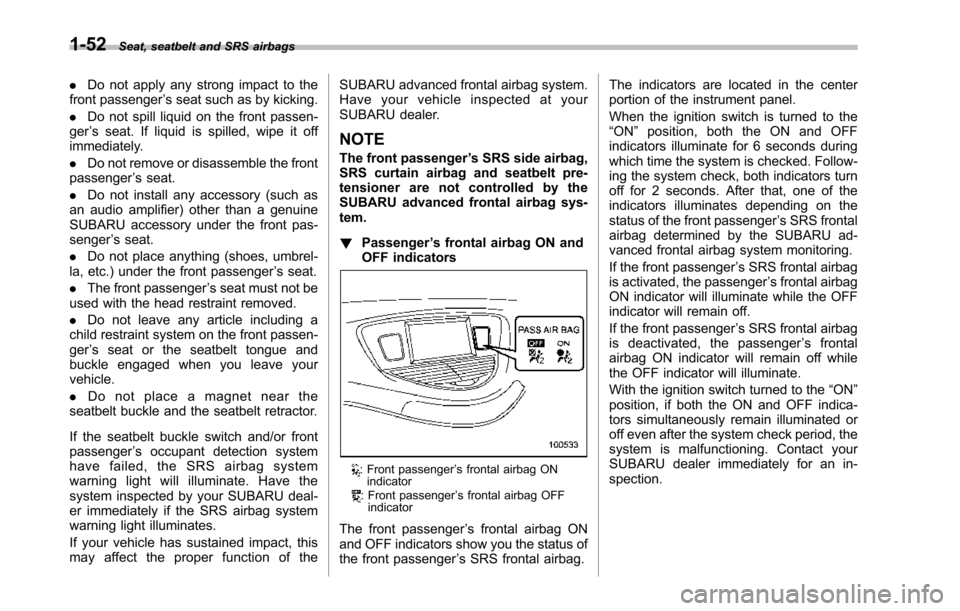
1-52Seat, seatbelt and SRS airbags
.Do not apply any strong impact to thefront passenger’s seat such as by kicking.
.Do not spill liquid on the front passen-ger’s seat. If liquid is spilled, wipe it offimmediately.
.Do not remove or disassemble the frontpassenger’s seat.
.Do not install any accessory (such asan audio amplifier) other than a genuineSUBARU accessory under the front pas-senger’s seat.
.Do not place anything (shoes, umbrel-la, etc.) under the front passenger’s seat.
.The front passenger’s seat must not beused with the head restraint removed.
.Do not leave any article including achild restraint system on the front passen-ger’s seat or the seatbelt tongue andbuckle engaged when you leave yourvehicle.
.Do not place a magnet near theseatbelt buckle and the seatbelt retractor.
If the seatbelt buckle switch and/or frontpassenger’s occupant detection systemhave failed, the SRS airbag systemwarning light will illuminate. Have thesystem inspected by your SUBARU deal-er immediately if the SRS airbag systemwarning light illuminates.
If your vehicle has sustained impact, thismay affect the proper function of the
SUBARU advanced frontal airbag system.Have your vehicle inspected at yourSUBARU dealer.
NOTE
The front passenger’s SRS side airbag,SRS curtain airbag and seatbelt pre-tensioner are not controlled by theSUBARU advanced frontal airbag sys-tem.
!Passenger’s frontal airbag ON andOFF indicators
: Front passenger’s frontal airbag ONindicator: Front passenger’s frontal airbag OFFindicator
The front passenger’s frontal airbag ONand OFF indicators show you the status ofthe front passenger’s SRS frontal airbag.
The indicators are located in the centerportion of the instrument panel.
When the ignition switch is turned to the“ON”position, both the ON and OFFindicators illuminate for 6 seconds duringwhich time the system is checked. Follow-ing the system check, both indicators turnoff for 2 seconds. After that, one of theindicators illuminates depending on thestatus of the front passenger’s SRS frontalairbag determined by the SUBARU ad-vanced frontal airbag system monitoring.
If the front passenger’s SRS frontal airbagis activated, the passenger’s frontal airbagON indicator will illuminate while the OFFindicator will remain off.
If the front passenger’s SRS frontal airbagis deactivated, the passenger’s frontalairbag ON indicator will remain off whilethe OFFindicator will illuminate.
With the ignition switch turned to the“ON”position, if both the ON and OFF indica-tors simultaneously remain illuminated oroff even after the system check period, thesystem is malfunctioning. Contact yourSUBARU dealer immediately for an in-spection.